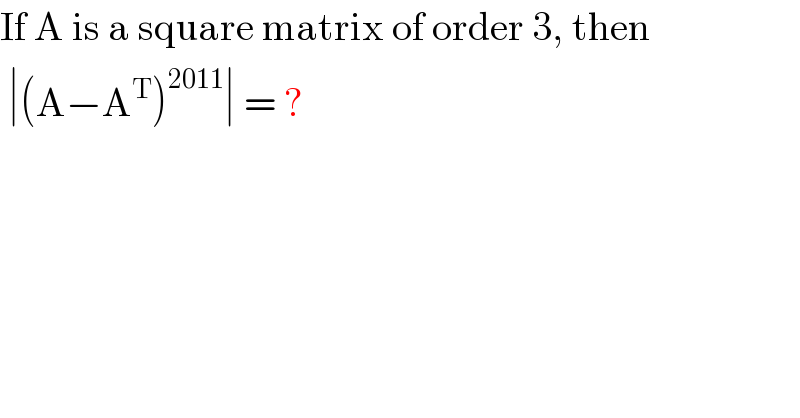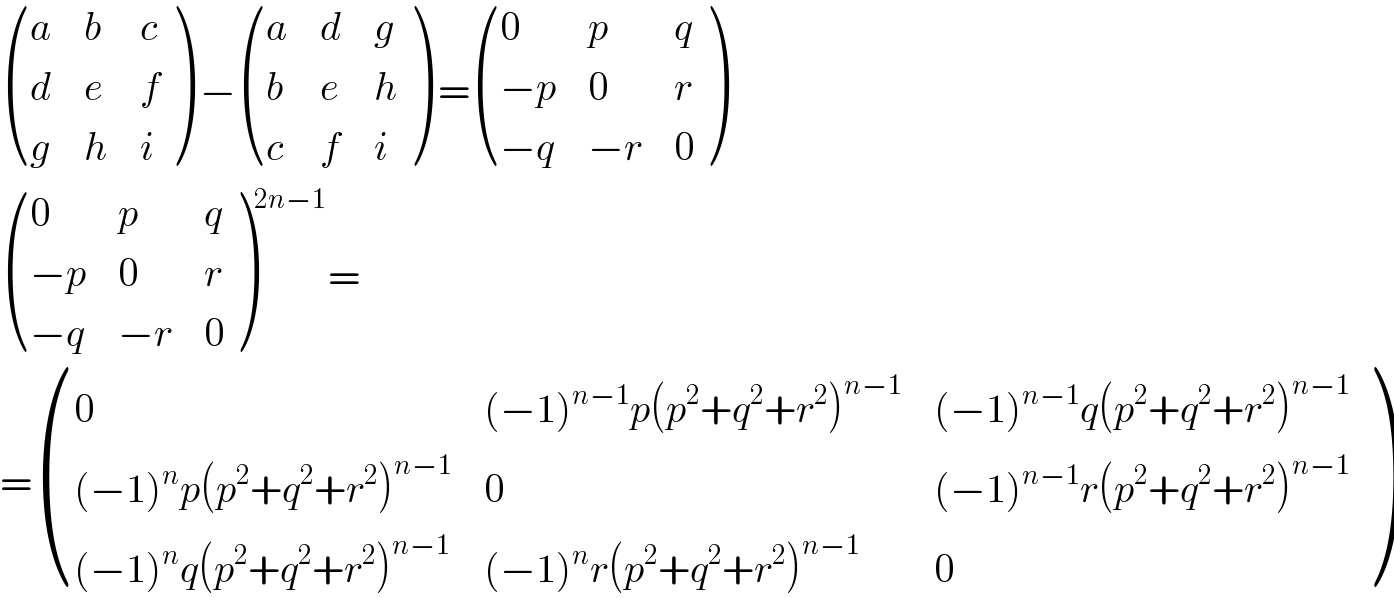
Previous in Matrices and Determinants Next in Matrices and Determinants
Question Number 41321 by rahul 19 last updated on 05/Aug/18

$$\mathrm{If}\:\mathrm{A}\:\mathrm{is}\:\mathrm{a}\:\mathrm{square}\:\mathrm{matrix}\:\mathrm{of}\:\mathrm{order}\:\mathrm{3},\:\mathrm{then} \\ $$$$\:\mid\left(\mathrm{A}−\mathrm{A}^{\mathrm{T}} \right)^{\mathrm{2011}} \mid\:=\:? \\ $$
Commented by rahul 19 last updated on 05/Aug/18

$$\mathrm{I}\:'\mathrm{m}\:\mathrm{getting}\:\mathrm{A}−\mathrm{A}^{\mathrm{T}} \:\mathrm{a}\:\mathrm{skew}\:\mathrm{symmetric}\: \\ $$$$\mathrm{of}\:\mathrm{order}\:\mathrm{3}. \\ $$$$\mathrm{I}\:\mathrm{wanted}\:\mathrm{to}\:\mathrm{know}\:\mathrm{why}\:\left(\mathrm{A}−\mathrm{A}^{\mathrm{T}} \right)^{\mathrm{2011}} \mathrm{will} \\ $$$$\mathrm{also}\:\mathrm{be}\:\mathrm{a}\:\mathrm{skew}\:\mathrm{synmetric}\:\mathrm{of}\:\mathrm{order}\:\mathrm{3}\:\:\:\:! \\ $$
Answered by MJS last updated on 05/Aug/18

$$\begin{pmatrix}{{a}}&{{b}}&{{c}}\\{{d}}&{{e}}&{{f}}\\{{g}}&{{h}}&{{i}}\end{pmatrix}\:−\begin{pmatrix}{{a}}&{{d}}&{{g}}\\{{b}}&{{e}}&{{h}}\\{{c}}&{{f}}&{{i}}\end{pmatrix}\:=\begin{pmatrix}{\mathrm{0}}&{{p}}&{{q}}\\{−{p}}&{\mathrm{0}}&{{r}}\\{−{q}}&{−{r}}&{\mathrm{0}}\end{pmatrix} \\ $$$$\begin{pmatrix}{\mathrm{0}}&{{p}}&{{q}}\\{−{p}}&{\mathrm{0}}&{{r}}\\{−{q}}&{−{r}}&{\mathrm{0}}\end{pmatrix}^{\mathrm{2}{n}−\mathrm{1}} = \\ $$$$=\begin{pmatrix}{\mathrm{0}}&{\left(−\mathrm{1}\right)^{{n}−\mathrm{1}} {p}\left({p}^{\mathrm{2}} +{q}^{\mathrm{2}} +{r}^{\mathrm{2}} \right)^{{n}−\mathrm{1}} }&{\left(−\mathrm{1}\right)^{{n}−\mathrm{1}} {q}\left({p}^{\mathrm{2}} +{q}^{\mathrm{2}} +{r}^{\mathrm{2}} \right)^{{n}−\mathrm{1}} }\\{\left(−\mathrm{1}\right)^{{n}} {p}\left({p}^{\mathrm{2}} +{q}^{\mathrm{2}} +{r}^{\mathrm{2}} \right)^{{n}−\mathrm{1}} }&{\mathrm{0}}&{\left(−\mathrm{1}\right)^{{n}−\mathrm{1}} {r}\left({p}^{\mathrm{2}} +{q}^{\mathrm{2}} +{r}^{\mathrm{2}} \right)^{{n}−\mathrm{1}} }\\{\left(−\mathrm{1}\right)^{{n}} {q}\left({p}^{\mathrm{2}} +{q}^{\mathrm{2}} +{r}^{\mathrm{2}} \right)^{{n}−\mathrm{1}} }&{\left(−\mathrm{1}\right)^{{n}} {r}\left({p}^{\mathrm{2}} +{q}^{\mathrm{2}} +{r}^{\mathrm{2}} \right)^{{n}−\mathrm{1}} }&{\mathrm{0}}\end{pmatrix} \\ $$
Commented by rahul 19 last updated on 06/Aug/18
thanks sir ����
